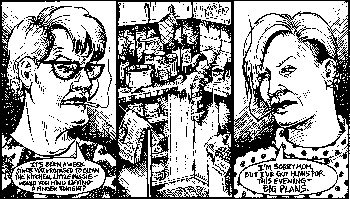![[Metroactive Books]](/books/gifs/books468.gif)
![[Metroactive Books]](/books/gifs/books468.gif)
[ Books Index | Metro | Metroactive Central | Archives ]
Walking Wounded
Phoebe Gloeckner examines her troubled family life with a doctor's surgical eye
WHEN PHOEBE GLOECKNER writes, "I don't really have pemphigus vulgaris," the news sent me racing to The Family Doctor CD-ROM (3rd edition). You really have no idea how many loathsome diseases there are waiting for you until you boot up this bad boy. The maladies are listed by alphabetical order. It's the hypochondriac's best friend--perfect bedtime reading. Are you going to wake up tomorrow morning with Pick's Disease or Cri du Chat Syndrome?
Gloeckner, author of A Child's Life and Other Stories (Frog Ltd.; 144 pages; $17.95) is a professional medical illustrator as well as a cartoonist. The author's self-portrait, which appears next to her introduction, is an ultrarealistic drawing of herself under siege by pemphigus vulgaris.
The following is provided as information only and should not replace the advice of a doctor--but if your skin blisters at the touch, it's the "Nikolsky sign," indicating what we unlicensed men of medicine like to call "p.v." Some will already have noticed those ulcerated blisters that start in the scalp and work their way into the nose, esophagus, rectum and eyelids.
The various wounds that affected Gloeckner took place when she was growing up, first in Philadelphia and then in San Francisco. A Child's Life and Other Stories records her life in cartoon form in the guise of various autobiographical characters, all with names starting with M: Mary, Magda and Minnie.
The collection, Gloeckner's first, represents 20 years worth of work originally printed in Wimmen's Comics, Weirdo and Young Lust. Apparently, the earliest piece--drawn with a Rapidograph and titled "Mary the Minor"--was done when Gloeckner was 16. The artist was a first-class cartoonist before she was old enough to vote.
MOST OF THE STORIES take place before 1978, when the artist turned 18. Unlike most adolescents, Gloeckner endured enough significant trouble to have something substantial to write about.
This trouble included the leering, vicious conduct of her icy stepfather. As described by Gloeckner, he was one of those people whose selfish cruelty is combined with an overwhelming sense of his own sophistication. He's the image of Me Decade self-absorption, pressing a copy of Open Marriage on Gloeckner's mother: "You may find that you want to consider the ideas it represents."
Gloeckner's Minnie loses her virginity at 15 to her mother's next boyfriend. The liaison is a source of shame mixed with obsessive love. To get over this hopeless affair, Gloeckner started hitting San Francisco's Polk Street in the company of the girl she also thought she loved. Gloeckner calls her "Tabitha." Tabitha was, at 12, a junkie and a veteran of porn movies. ("Tabitha did not emerge intact," Gloeckner writes) and passed on the bad treatment, whoring the author out in exchange for heroin.
There's an element of prettiness in Gloeckner's style that makes the pain she records all the more difficult to shake off. Like all cartoonists, Gloeckner uses physical distortion; she's fond of outsized heads and large eyes. But her narratives aren't tales from a wounded fawn. In her 1996 story "The Girl From a Different World," for instance, Gloeckner tries to imagine, with sympathy, what it would be like for a high school boy who can't handle the emotional history of a girl who sleeps with her own stepfather.
The art in this collection demonstrates a wide variety of techniques--it's the narrative that binds the different styles together. Gloeckner relies on many different media: airbrush, computer paint and, lately, some abstracts, using her medical illustrative training for fine art. She drew a "visible woman" for her book cover for an edition of J.G. Ballard's The Atrocity Exhibition for Re/Search Press. Some of her newest work includes detailed, anatomically accurate cross-sections of penises and jaws; the pathologist's view of the blowjob.
Near the end of A Child's Life and Other Stories, there's an unexpectedly tender note; a pair of etchings depicting the artists' mother and husband. The mother's face is full of challenge and bitter self-amusement; the husband's portrait is purely affectionate, even idealized. (It's amazing that Gloeckner would give this man a break after what she's been through.)
Gloeckner writes in the introduction, next to her disfigured self-portrait, that a husband, a child and some success in the "normal" world have helped give her some of the strength to tell her story. "I no longer feel the necessity to hide," she writes.
She also notes that the great bulk of the work was done in the last five years. There's hope, then, for more frighteningly intense art from this important artist. Gloeckner's powerful record of a youth in the '70s is essential to understanding what an impossibly different landscape it was from today.
[ San Jose | Metroactive Central | Archives ]
Copyright © Metro Publishing Inc. Maintained by Boulevards New Media.
![]()

Mother vs. Daughter: The generations do not see eye to eye in 'An Evening in Prague' from 'A Child's Life' by Phoebe Gloeckner.
From the September 3-9, 1998 issue of Metro.